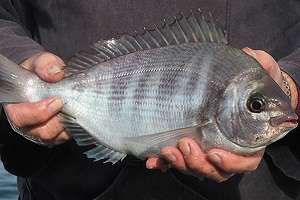Fishermen join scientists to track estuary black bream

Recreational fishermen are helping researchers in an ambitious three-year study to find out more about the popular black bream (Acanthopagrus butcheri) fish species.
The Murdoch University project, involves researchers tagging and tracking 4000 black bream in seven estuaries; Moore Estuary, Swan-Canning River, Murray River and the Walpole-Nornalup, Wilson, Wellstead and Culham inlets.
Project coordinator Dr Joel Williams, from Murdoch's Centre for Fish, Fisheries and Aquatic Ecosystems says tagging the black bream will allow researchers to track their movements over time.
"Murdoch University has been doing a lot of research on black bream for decades and one thing that they have come to realise is that they are quite unique because it completes its entire life cycle in a single estuary with very little connectivity between estuaries," Dr Williams says.
"What they found is that populations are isolated from other populations, that bream in the Swan estuary have a different growth pattern than bream in other estuaries.
"One of our tasks is to look at what leads to this difference in growth rate, reproductive cycle, size of maturity when they spawn and what they are feeding on and try and work out if this is environmental or fishing pressures or estuary type."
That will allow the researchers to start to develop some hypotheses on what the impact of climate change and human impacts will have on local bream into the future.
Dr Williams has so far recruited 15 recreational fishermen, who have been given 50 tags each which they will insert into the dorsal fin via a needle gun of any black bream they catch, before releasing them.
"Each fish has a unique number and whenever these fish get re-caught, they can call the number and report the fish number, the size and where they caught the fish," he says.
"That way we can track where the fish are moving in the system and the growth through time."
Black bream grow to about 60cm and weigh 4kg.
Dr Williams admits the prospect of tagging 4000 black bream, a popular recreational and commercial species found in south-western Australia, is optimistic.
He doesn't expect any tagged fish to be re-caught for at least six months.
The study started in January this year and will finish in 2016.
Provided by Science Network WA



















